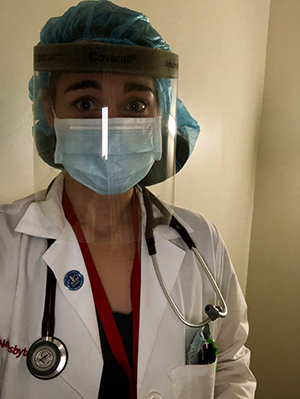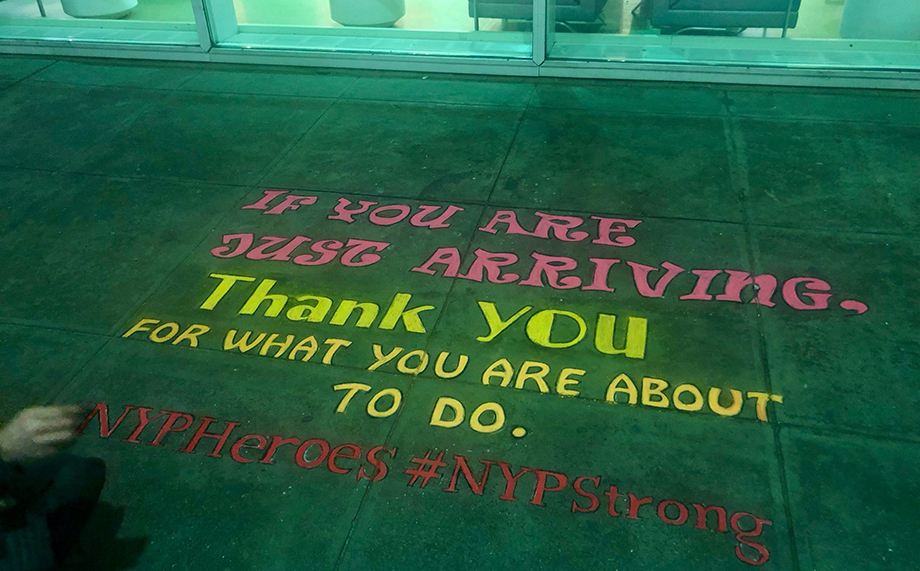SLU Physician Assistant Alumna Fights COVID-19 in New York City
Mostly, I'm thankful for the greatest example of love in action I have ever seen - how much we care for those we will never meet by staying home.
Kelsey Ziesig, SLU PA Alumna, New York City
The COVID-19 virus has made its presence felt in every region of our world – a truly global phenomenon. While every big city and small town feels the repercussions of the pandemic, some areas have been impacted more than others. New York City has been the COVID-19 epicenter for the United States, bringing a population of more than 8 million people to a standstill. Already with hundreds of thousands of confirmed cases and tens of thousands of deaths, the city’s health care workers have emerged as heroes helping to fight the virus and save as many lives as possible. One of those heroes is Saint Louis University Physician Assistant alumna Kelsey Ziesig, PA-C.
Ziesig works at New York Presbyterian – Columbia University Medical Campus as a physician assistant on the internal medicine team. She has worked in that position for a year and explained that no amount of training or experience could have completely prepared her for what her position has become during the pandemic.
“No one prepares you to work in the epicenter of a pandemic one year into your first professional job. Before this started, my service floor treated floor acuity patients with a variety of different medical conditions. Of course, emergencies happened on the floor – and we’d triage those – but it wasn’t the normal day-to-to activity,” Ziesig said.
COVID-19 changed that.
“For the last two months, our days have been filled with multiple stat intubations and rapid responses/codes for respiratory distress and cardiogenic shock,” Ziesig said. “Now, having patients on ventilators in makeshift ICUs is the norm.”
Growing up, Ziesig spent a fair amount of time in doctors’ offices and met amazing health care providers that made her feel not only cared for, but understood as well. This inspired Ziesig to pursue a career in health care.
“Those doctors changed my life for the better and I knew I wanted to do the same for people one day,” Ziesig said. “To medically treat someone is one thing, but I wanted to make their health care experiences positive as well.”
It is this compassion for the patient that pushes Ziesig and other health care professionals to cast thoughts of their own wellbeing aside and fight for these COVID-19 patients.
“There is a lot of fear and anxiety that surrounds work. I think a lot of people outside of health care assume the fear is that we are going to catch the virus – that’s not true. The fear is what you are going to see in these rooms,” Ziesig said. “Seeing people gasping for air on maximum oxygen support short of mechanical ventilation time and time again. Seeing the gut-wrenching sobs as you Facetime a family so they can say goodbye to a loved one. Seeing yet another person fall victim to this virus – alone. Those are the things we fear now.”
Facing this enemy and seeing its effects daily has given Ziesig and her coworkers a kind of tunnel vision that helps them stay focused on the task at hand and remain strong for the patients.
“I am lucky to work with some of the most selfless and kind people alive. They inspire me on a daily basis to do the best by our patients that only have us,” Ziesig said. “When I feel exhausted and run down, I remind myself of how I would want my loved one to feel if they were admitted to a hospital right now with this virus and no one able to visit. I worry there will be a lot of health care worker burnout from this time, but right now we’re exclusively focused on being there for our patients.”
It isn’t only behind hospital walls that Ziesig sees the effects of the COVID-19 pandemic. The disease has completely altered the landscape of America’s most populated city.
“It’s surreal to see a city of over 8 million people, known for its vibrance, shuttered. It’s eerie. My train ride to work that was previously standing room only is now maybe five other people, all of us in masks and gloves. Streets that were previously teeming with people are completely empty; it’s not the New York any of us are used to,” Ziesig said.
Despite the shutdown, Ziesig said that New Yorkers still know how to make their presence felt.
“While I miss the fast-paced, social New York, I have never been more proud to be a resident of this city,” Ziesig said. “Everyone is doing their part to fight the virus, and it’s getting better. While we can’t be together like we used to, I feel such a sense of unity – especially in the booming applause for essential workers at 7:00 pm each night.”
In trying times, it can be easy to get caught up in the hardships. It is important, perhaps now more than ever, to make sure to notice the blessings, the joys, the triumph of the human spirit. Ziesig explained that, even now – especially now – the community is showing its strength.
“I think this has revealed the best in so many people. I’m blown away by my fellow health care workers who show up every day,” Ziesig said. “I’m blown away by the generosity the community has shown us – donating meals, PPE, etc. I’m thankful for friends and family who have littered my mailbox with sweet messages and always checking in. But mostly, I’m thankful for the greatest example of love in action I have ever seen – how much we care for those we will never meet by staying home.”

